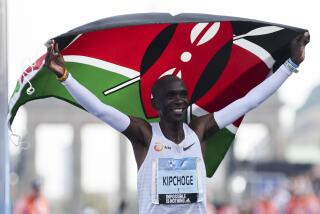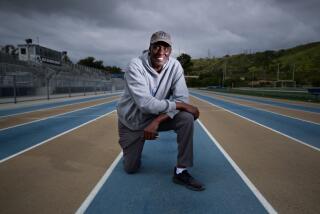Run by Using Your Head, Especially If a Rhino Is Coming
- Share via
Kip Keino taps the side of his head and distills years and volumes of training theory and race strategy down to three words.
“Running is here,” he says.
Who would know better than Kipchoge Keino (it’s pronounced KAY-no), just possibly the most remarkable runner in the history of running?
This is the Nandi tribesman who was raised on a remote tea plantation in Kenya, who never had a coach, never saw a track shoe until he was 22, never got paid, never took a vitamin, and yet won two Olympic gold medals, inspired his nation and brightened the sports world for more than a decade.
As a boy, living in a mud hut in the mountains that straddled the Equator, Kip’s athletic education consisted mainly of survival tips, such as how to deal with a charging elephant or rhino.
His tips? Make an elephant chase you downhill, so gravity will cause his (or her) ears to flop over his eyes, then run in circles, out of the beast’s obstructed vision. Rhinos are fullbacks, they don’t cut well, so a zigzag fleeing pattern works best.
Keino’s running role models were antelopes and hyenas and leopards. As he developed and began to compete at higher levels, he listened only to his own instincts, was pushed and prodded and encouraged only by the coach inside him.
At 18 he joined the police force and was stationed for three years at a desert outpost, where he couldn’t run. He returned to civilization at 21 and began to ease into global competition. No coach, no club, no sponsor, no shoes. The head, though, was racing state-of-the-art.
One race sums up Keino’s career. The 1,500 meters--the metric mile--in the Mexico City Olympics, 1968. The favorite is Jim Ryun, undefeated for three years. Keino is supposedly over the hill at 28. He is plagued by violent stomach pains from what will prove to be a severe gall bladder infection. His wife, back home, is about to deliver a baby. On the way to the stadium, his car is caught in traffic and he must jog a mile to get there on time.
Keino hangs near the back of the pack for the first lap, then takes off like a rocket, setting a preposterous, suicidal pace.
Explaining that strategy now, Keino says: “You take it as it comes.”
Keino beats a gasping Ryun by 20 meters, the widest winning margin for that event in Olympic history, and sets an Olympic record, 3 minutes 34.9 seconds, that stands for 16 years. Later that day, Kip’s wife gives birth to a daughter, Milka Olympia Chelagat.
Ryun, Keino now explains sympathetically, was simply a victim of heavy pressure.
“People expect him to win,” Keino says.
But what about Keino? His nation had never had a gold-medal winner. Only one bronze. Surely he felt enormous pressure to win?
“Yes,” he says. “But you have to play it cool.”
Keino won a steeplechase gold medal four years later. He became a star on the American indoor track circuit. He had an elegant and tireless style, and he would bring fans to their feet when, to signal his killer finishing kick, he whipped off his knit cap and flung it aside.
A warm, intelligent, friendly man, he made friends all over the world.
Then Keino, who never received a dime to run, was knocked out of track in 1975 when he took money over the table to join the short-lived International Track Assn. Thus he was denied a chance to run in his fourth Olympic Games.
“One of those things,” Keino says. “I call it a day.”
He took his ITA money and bought 200 acres of farm land in Kenya. Today he owns a tea plantation, a dairy and beef farm, apartments and a sporting goods store. How far he has come from the thatched-roof days.
“Now I have a tile roof,” he says.
On the side, Keino coaches the Kenyan national track team. After inspiring an entire continent to take up serious distance running, he now passes on his knowledge.
He stays busy.
“Life is very hard, and you have to have a challenge,” says Keino, who tends to say a lot with few words. “I would say I’m doing my best.”
Keino has two sons in American schools, and an 11-year-old son back home who runs like the old man.
At 47, Kip still runs regularly. He’s in Los Angeles right now to team up with another legend, Billy Mills, in Saturday’s Foot Locker Partners Nationals at Playa del Rey.
This run is for fun.
“After certain years,” Keino says, “it is good to have a joke.”
More to Read
Go beyond the scoreboard
Get the latest on L.A.'s teams in the daily Sports Report newsletter.
You may occasionally receive promotional content from the Los Angeles Times.






